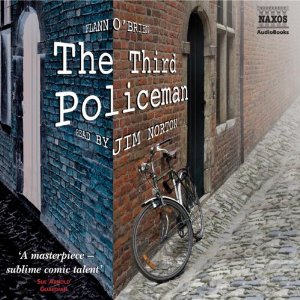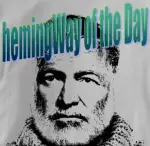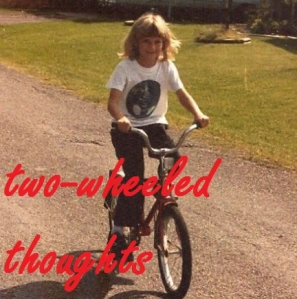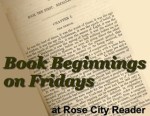 This will win the Pagesofjulia Perplexing and Peculiar Award of 2016, which I have just invented.
This will win the Pagesofjulia Perplexing and Peculiar Award of 2016, which I have just invented.
Flann O’Brien is one of the pen names of Brian O’Nolan (he also wrote under the name Myles na gCopaleen, or Myles na Gopaleen; Brother Barnabas; etc.). This novel came to me first from this list by the Guardian, and then from my friend Barrett, who bought me O’Brien’s At Swim-Two-Birds when we were traveling in Ireland together several years ago. (I still have not read that one.)
The Third Policeman is not so strictly about bicycles or cycling as the Guardian list had led me to believe; I was quite confused for the first, oh, third or so of the book. Our unnamed narrator is an odd one. He was orphaned, lost a leg, and then returned home from college to find his parents’ pub managed by a man named Divney, who is clearly embezzling from the business. Narrator is quite obsessed with a (fictional) scientist-philosopher named de Selby, about whom he writes a definitive work that he cannot afford to have published. This financial need is set up as his motivation to join in a plot with Divney to rob and murder a neighbor, the wealthy Mathers. After the murder, Divney hides the money, inspiring Narrator to follow him around closely, finally sleeping in the same bed to prevent Divney’s sneaking off to recover the funds alone. Very strange, right? It gets stranger. Narrator meets a figure who is, apparently, the ghost of Mathers; Narrator’s soul speaks up quite suddenly, is named Joe, and becomes an occasional participant in dialog; Narrator hikes off to find a certain police station where he wants to report the theft of a nonexistent watch, thereby seeking clues as to Mathers’s missing money; etc. When we meet the policemen (only two of them, the titular third being absent), we get into the bicycle-related part of the book, but nothing makes any more sense than before. Remember de Selby, Narrator’s obsession? Footnotes throughout discuss his life and work (gradually revealing that he was perhaps less the genius than Narrator would have us think), and, digressively, the lives and petty conflicts of de Selby’s other biographers. WHEW.
The policemen, in turn, are obsessed with bicycles. (Recall this teaser.) Apparently in their world, those who spend too much time on their bicycles become bicycles. You know I loved this part.
This plot, if I may call it that, is every bit as twisted and weird and disconnected as it sounds. Despite all that, it is entertaining, stylish in its own way, and yes, smart. Narrator has a strong voice and personality, strange though he be. The policemen have interesting theories and skills, metaphysical and philosophic. And I have by no means hinted at the central questions of the book yet; there is a final big reveal that makes you think. No spoilers here! and you should avoid them elsewhere to keep The Third Policeman‘s full effect intact.
As far as I can tell, O’Brien gets credit with coining a usage of the word ‘pancake’ for ‘puzzle.’ His policemen use it repeatedly:
It is one of the most compressed and intricate pancakes that I have ever known.
…nearly an insoluble pancake…
A very unnatural pancake. A contrary pancake surely…
And thus my rating: this book is a contrary pancake surely.
The real live narrator, who reads this audiobook for us, is Jim Norton, and he does a splendid job. I felt pulled into a surreal world that I enjoyed and giggled at and was occasionally disturbed by. I’m sure I missed two-thirds at least of the opportunities to interpret this work as a piece of philosophy, itself, but I was utterly entertained. The audio format worked well for letting the zaniness just wash over me. It would not be ideal for close reading, of course – never is – but I really appreciated the experience of this audio introduction to Flann O’Brien, or whatever he calls himself, and I will read more. Don’t be too intimidated – just, don’t expect to understand everything you hear. I’m sure O’Brien has been the subject of a few dissertations, and is probably ripe for another, if you’re feeling ambitious.
Rating: 7 pancakes.
Filed under: book reviews | Tagged: audio, bikes, humor, misc fiction | Leave a comment »















